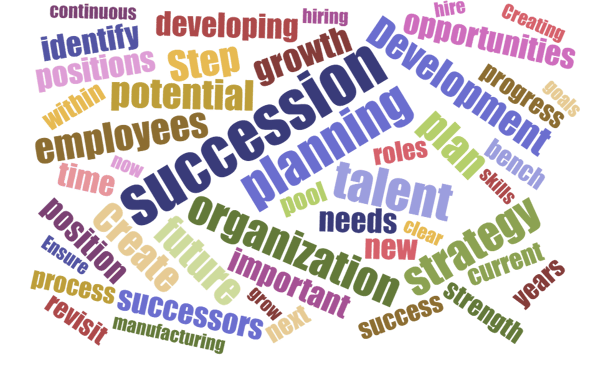
Recruiting and hiring new employees is costly and time-consuming. It has been noted, an average organization loses anywhere between 1% and 2.5% of revenue on the time it takes to onboard and orientate a new hire to their position. And manufacturing organizations are experiencing a steady decline in hiring.
According to the U.S. Bureau of Labor Statistics, employment in production occupations is projected to show little or no change, with a loss of about 39,000 jobs from 2020 to 2030. Technology advancements in manufacturing sectors will greatly impact the way organizations engage in commerce. It is important to invest in developing current employees now, to optimize your internal talent pool to respond to these ever-changing business shifts and market requirements.
What is Success Planning
Simply put, Succession Planning is maximizing your workforce potential. Succession planning and building talent bench strength is a structured approach and process to ensure the future stability and growth of your organization. Developing and promoting talent from within the organization gives you the ability to establish clear future-oriented goals to grow and develop necessary skills. Creating and implementing a Succession Planning Strategy provides significant benefits to organizations:
- Creating a continuous learning culture
- Development of career pathways aligned to future growth opportunities
- Increased employee engagement and retention
- Increased management visibility to employee’s readiness and aspirational leadership potential
- Decreasing the costs and time for search to hire and in the amount of time filling key positions
An Effective Solution
When considering a strategy for talent succession planning, there are many models to choose from. Depending on the needs of an organization, a tailored approach works best to incorporate into work practices and culture. The most effective models follow a 5-Step process:

For each of these steps, we’ve provided best practices and suggestions to the respective step.

Step 1 – Analyze HR Data
Prior to developing a succession strategy, it’s important to identify how many impending retirements and transitions are anticipated within the next 1-5 years. This allows for a thorough reflection of current and future needs – will the organization have sufficient coverage for those positions? Gathering essential data also allows for a better analysis of the organization’s talent gap and opportunities to build bench strength – is there a retirement risk among the candidates in line for succession today? Currently, how ready is the organization’s talent pool for succession?

Step 2 – Position Profiling
Before identifying potential successors, revisit the organization chart and consider how its business strategies might evolve over the next 5-7 years. Create a position profile for key roles and discuss with the succession strategy planning team how these positions have changed over time. What new capabilities are required to address changing business strategies and the future of work? Once new capabilities are determined for each position profile, align the talent and skills of potential successors to those roles.

Step 3 – Identify High-Potentials
To maximize succession planning efforts, it’s important to identify high-potential employees through performance metrics and outputs. It’s also important to assess who is ready now and who might be in the next 3-5 years. Ensure to ask the succession candidates about career aspirations and if their professional goals align to potential succession. As current succession competencies and needs are identified, it will be essential to remain mindful of what competencies are required for the organization to grow and evolve. This will allow for the assessment of a broader and more diverse talent pool as you consider future organizational needs.

Step 4 – Create Training and Development Plans
Provide training, coaching, and development opportunities and solutions that address talent gaps and create accountability for leaders to support these continued development efforts. Create an advanced development plan with identified successors and actively monitor their growth and progress. Pay attention to who is taking initiative to use the tools and resources provided by the company to enhance their growth. Who are the ones asking for continuous feedback and coaching opportunities? You may be able to identify emerging leaders who otherwise blend in with their peer group and likewise, you may discover a few people targeted as high potentials who display lower levels of aspiration for growth and succession.

Step 5 – Assess Progress and Revisit Succession Plans
The success of an organization’s succession planning strategy depends on the commitment and execution of the plan. Continued assessment of the potential successors’ progress will be imperative throughout the succession planning endeavor. Periodically revisit the succession plan to see if it remains aligned with the organization’s strategies or determine if changes need to be made.
Succession strategy planning matters – for employees and for the future of organizations. A clear plan helps employees visualize a path for themselves within the company and provides a sense of inclusion and belonging.
Need to revise – or create – your succession planning strategy? Let’s chat for 15 minutes to see how IMEC can help.
In the meanwhile, watch the on-demand webinar: PASS THE TORCH: Where to Begin to Create an Effective Succession Plan Webinar where I discuss the 3 initial and essential steps to effectively begin a strategic succession plan:
- Development of an ongoing talent strategy process of defining organization roles and capacities needed for future state success
- Pro-active planning for impending retirements and/or leadership transitions
- How to evaluate and prepare individual contributors for leadership positions





